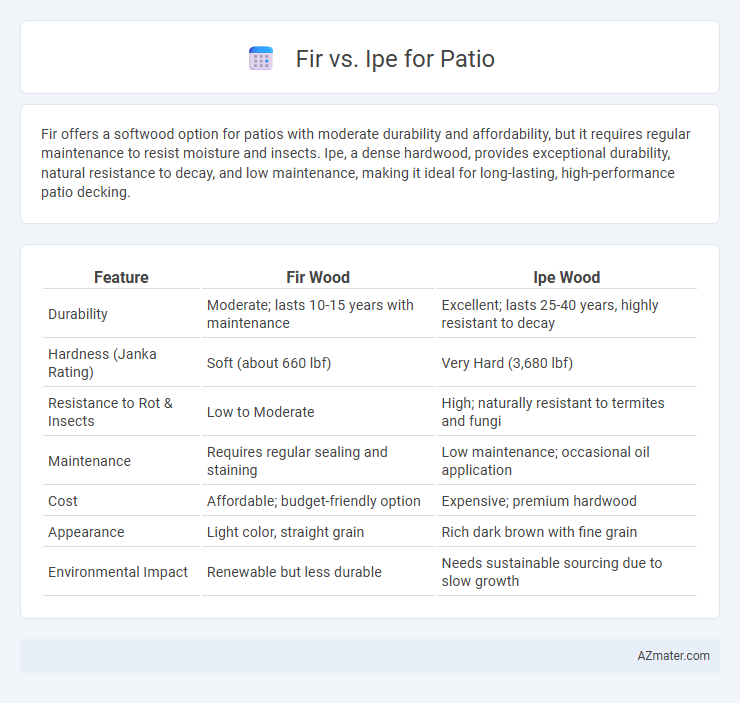Fir offers a softwood option for patios with moderate durability and affordability, but it requires regular maintenance to resist moisture and insects. Ipe, a dense hardwood, provides exceptional durability, natural resistance to decay, and low maintenance, making it ideal for long-lasting, high-performance patio decking.
Table of Comparison
| Feature | Fir Wood | Ipe Wood |
|---|---|---|
| Durability | Moderate; lasts 10-15 years with maintenance | Excellent; lasts 25-40 years, highly resistant to decay |
| Hardness (Janka Rating) | Soft (about 660 lbf) | Very Hard (3,680 lbf) |
| Resistance to Rot & Insects | Low to Moderate | High; naturally resistant to termites and fungi |
| Maintenance | Requires regular sealing and staining | Low maintenance; occasional oil application |
| Cost | Affordable; budget-friendly option | Expensive; premium hardwood |
| Appearance | Light color, straight grain | Rich dark brown with fine grain |
| Environmental Impact | Renewable but less durable | Needs sustainable sourcing due to slow growth |
Introduction to Fir and Ipe for Patios
Fir and Ipe are popular wood choices for patios due to their durability and aesthetic appeal. Fir offers a lightweight, cost-effective option with moderate resistance to decay, ideal for temperate climates. Ipe, a dense hardwood from South America, provides exceptional durability, natural resistance to pests and weather, and a rich, dark color that enhances outdoor spaces.
Overview of Fir Wood Characteristics
Fir wood, commonly used in patio construction, offers a lightweight yet durable option with a fine, even texture and a straight grain that enhances its visual appeal. It has moderate natural resistance to decay and insects but typically requires proper treatment or sealing to ensure long-term performance in outdoor settings. Fir's affordability and ease of workability make it a popular choice for budget-friendly patio projects, although it may not match the exceptional hardness and weather resistance found in tropical hardwoods like Ipe.
Exploring Ipe Wood Properties
Ipe wood offers exceptional durability and natural resistance to rot, insects, and weather, making it ideal for patio construction. Its high density and hardness provide superior scratch resistance compared to softer woods like fir, ensuring longevity in outdoor environments. Ipe's rich, dark brown color enhances patio aesthetics while aging gracefully with minimal maintenance requirements.
Durability: Fir vs Ipe Comparison
Fir wood is moderately durable but prone to decay and insect damage in outdoor patio settings, requiring regular maintenance and sealing to extend its lifespan. Ipe, a dense tropical hardwood, offers superior durability with natural resistance to rot, insects, and weathering, lasting up to 40 years or more without significant deterioration. For patio applications where longevity and minimal upkeep are priorities, Ipe outperforms Fir due to its exceptional hardness and resistance to environmental stressors.
Weather Resistance and Longevity
Ipe is renowned for its exceptional weather resistance and longevity, often lasting 25 to 40 years without significant decay due to its dense, oily grain that repels moisture and resists insect damage. Fir, while more affordable and easier to work with, generally offers lower durability and requires regular sealing and maintenance to withstand outdoor elements, typically lasting around 10 to 15 years. Choosing Ipe for a patio ensures superior resistance to rain, sun, and temperature fluctuations, making it a premium option for long-lasting outdoor decking.
Maintenance Requirements for Fir and Ipe
Fir wood requires regular sealing and staining to prevent moisture damage and maintain its appearance, as it is more susceptible to rot and insect infestation. Ipe, a dense hardwood, demands less frequent maintenance due to its natural oil content, which provides superior resistance to decay, insects, and weathering. Homeowners choosing Ipe benefit from longer intervals between refinishing, typically every 3-5 years, compared to Fir's annual or biennial upkeep.
Aesthetic Differences: Color and Grain
Fir wood offers a lighter, natural tone with a pale yellow to reddish-brown color and a straight, uniform grain, providing a clean and classic look for patios. Ipe, renowned for its rich, deep brown hues with reddish or olive undertones, features a tight, dense grain that creates a luxurious, sophisticated aesthetic. The contrasting color intensity and grain patterns make Fir ideal for a bright, airy patio design, while Ipe suits those seeking a bold, elegant outdoor space.
Cost Analysis: Fir vs Ipe Budget Considerations
Fir offers a significantly lower upfront cost compared to Ipe, making it a budget-friendly option for patio construction without compromising structural integrity. Ipe, while more expensive initially due to its dense hardness and durability, demands less maintenance and has a lifespan of up to 40 years, often offsetting higher initial expenses with long-term value. Cost analysis should weigh Fir's affordability against Ipe's longevity and resistance to weather, insects, and rot, guiding homeowners toward a choice that aligns with their financial and durability priorities.
Environmental Impact and Sustainability
Fir, sourced from fast-growing softwoods, offers a lower environmental impact due to its rapid renewability and carbon sequestration during growth. Ipe, a dense tropical hardwood, boasts exceptional durability and longevity, reducing the need for replacement and resource consumption over time, but its harvesting raises concerns about deforestation and habitat loss. Choosing sustainably certified fir or Ipe with verified legal sourcing ensures reduced ecological footprint and supports responsible forest management for patio construction.
Choosing the Best Wood for Your Patio
Fir offers affordability and ease of installation for patio construction but lacks the natural durability and resistance to decay found in Ipe, making it less ideal for long-term outdoor use. Ipe, a dense tropical hardwood, boasts exceptional hardness, resistance to rot, insects, and weather, ensuring a patio that can last decades with minimal maintenance. Choosing Ipe over Fir means investing in a premium, durable wood that withstands harsh environmental conditions while preserving its rich appearance.

Infographic: Fir vs Ipe for Patio
 azmater.com
azmater.com